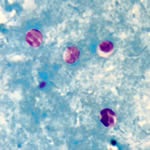Cryptosporidiosis laboratory tests: Difference between revisions
| Line 6: | Line 6: | ||
==Laboratory Findings== | ==Laboratory Findings== | ||
Image below shows cryptosporidium oocyst in modified acid fast stain. | |||
[[Image:Cryptosporidium.jpg|150px|left]] | |||
===Stool Test=== | |||
Diagnosis of cryptosporidiosis is made by examination of stool samples. Because detection of Cryptosporidium can be difficult, patients may be asked to submit several stool samples over several days. Most often, stool specimens are examined microscopically using different techniques (e.g., Acid fast stain|acid-fast staining, direct fluorescent antibody DFA , and/or enzyme immunoassays for detection of Cryptosporidium sp. antigens). | Diagnosis of cryptosporidiosis is made by examination of stool samples. Because detection of Cryptosporidium can be difficult, patients may be asked to submit several stool samples over several days. Most often, stool specimens are examined microscopically using different techniques (e.g., Acid fast stain|acid-fast staining, direct fluorescent antibody DFA , and/or enzyme immunoassays for detection of Cryptosporidium sp. antigens). | ||
===PCR=== | |||
Molecular methods (e.g., [[polymerase chain reaction]] – [[PCR]]) are increasingly used in reference diagnostic labs, since they can be used to identify Cryptosporidium spp. at the species level. Tests for Cryptosporidium are not routinely done in most laboratories; therefore, health care providers should specifically request testing for this parasite. | Molecular methods (e.g., [[polymerase chain reaction]] – [[PCR]]) are increasingly used in reference diagnostic labs, since they can be used to identify Cryptosporidium spp. at the species level. Tests for Cryptosporidium are not routinely done in most laboratories; therefore, health care providers should specifically request testing for this parasite. | ||
Revision as of 21:59, 20 November 2012
Editor-In-Chief: C. Michael Gibson, M.S., M.D. [1]
|
Cryptosporidiosis Microchapters |
|
Diagnosis |
|---|
|
Treatment |
|
Case Studies |
|
Cryptosporidiosis laboratory tests On the Web |
|
American Roentgen Ray Society Images of Cryptosporidiosis laboratory tests |
|
Risk calculators and risk factors for Cryptosporidiosis laboratory tests |
Overview
Laboratory Findings
Image below shows cryptosporidium oocyst in modified acid fast stain.

Stool Test
Diagnosis of cryptosporidiosis is made by examination of stool samples. Because detection of Cryptosporidium can be difficult, patients may be asked to submit several stool samples over several days. Most often, stool specimens are examined microscopically using different techniques (e.g., Acid fast stain|acid-fast staining, direct fluorescent antibody DFA , and/or enzyme immunoassays for detection of Cryptosporidium sp. antigens).
PCR
Molecular methods (e.g., polymerase chain reaction – PCR) are increasingly used in reference diagnostic labs, since they can be used to identify Cryptosporidium spp. at the species level. Tests for Cryptosporidium are not routinely done in most laboratories; therefore, health care providers should specifically request testing for this parasite.